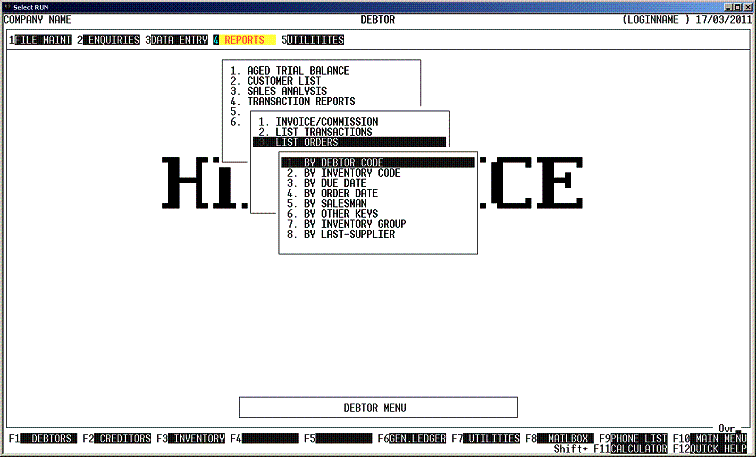HiFinance
5
SECTION
1.4.4.3 - LIST ORDERS
USAGE: To print a list of Debtor Sales Orders. This is
used in cases where you wish to check the entries on orders before initiating a
bulk update or for checking what stock is committed where.
Note: This program specifically ignores any
orders that do not relate to Inventory. Thus this report cannot be used if you
enter orders that relate to General Ledger lines or Jobs. Also, text lines are
ignored and any freight is not shown.
DISCUSSION: When you choose this option, the screen will
appear as follows:

Here you can choose the order in which you wish to
print the report. Choose the order you wish to print the report in by pressing
the number next to the option. If you choose to print BY OTHER KEYS, another menu will open to allow you to specify
which of the three OTHER KEYS you actually require.
Hint: If you intend to limit the report to a range of
transactions, it is most efficient to print the report in the same order. Eg if
you wish to limit the report to a range of salesmen, the report will scan the
transaction-file faster if you also print the report in salesman order.
Having chosen from the options, the following
questions will appear:
USE LONG FORMAT REPORT If you are using wide stationery, reply Y, otherwise reply N. This question will only be
displayed if the relevant option is set to A, see SECTION 7.1.2.
START A NEW PAGE ON
CHANGE OF KEY If you have chosen to print
the report in Debtor, date or Salesman order, you will be offered this option.
If you reply Y, HiFinance will start a new
page each time the major key changes. A sub-total will also be printed for each
group of transactions. If you reply N, the transactions will be
printed continuously.
PRINT SUB-TOTALS ONLY If you have chosen not to start a new page on change of key
(see above) you are asked if you wish to print sub-totals only. If you choose Y, you will be given a short report that only print one line for each key
(eg Debtor code). Also, the report will only detail the key, the units ordered,
units left to deliver and the value of the units left to deliver.
PRINT COMPLETED ORDERS Normally you would want to exclude completed orders
from the report unless you specifically wish to just list completed orders. In
either case, reply Y or N, as required.
PRINT UNCOMPLETED ORDERS The default answer to this question is Y, but if you wish to print completed orders only, rely N.
PRINT COMPLETED LINES When you update an Order to an Invoice, HiFinance
tags lines as completed when you invoice at least as much as has been ordered.
If you wish to have these completed lines included in the report, reply Y. Note that choosing N for COMPLETED ORDERS (above) overrides this option.
PRINT UNCOMPLETED LINES This option is similar to the previous question
except that it refers to uncompleted lines. Again you should note that choosing
N for COMPLETED
ORDERS (above)
overrides this option.
ONLY PRINT LINES WITH
POSITIVE STOCK-ON-HAND This option allows you to
filter-out Inventory items that have nothing in stock. This can be useful for
deciding which orders can be filled.
The following question asks you to enter both a
lower and upper limit. The upper limit must not be less than the lower limit.
The default answers define the extreme limits of the field. You do not have to
change all of these limits. Only change the ones you wish to, and tab past the
others.
DEBTOR CODE RANGE This is the Debtor’s code.
INVENTORY CODE RANGE This is allows you to print only orders for a range of
Inventory codes.
DUE DATE RANGE This allows you to limit the report to a range of Due Dates, eg to
list only back-orders, enter 01/01/0001 for the lower limit and
yesterday’s date for the upper limit.
ORDER DATE RANGE This allows you to limit the report to a range of date’s
ordered. This can be used to find a lost order or to organise deliveries in
batches.
SALESMAN RANGE This is the salesman code as it appears on the transaction-file (not
the Debtor master-file).
OTHER KEY RANGES These may appear as a different literal depending on how you
have defined the fields in SYSTEM
PARAMETERS.
REFERENCE RANGE This reference number, i.e. Order number.
To start the report, press <Enter> through each field or simply press <F10>.
The report will scan the transaction file and
extract all records that fit within your chosen parameters. The report itself
will detail the Debtor code and name, Salesman number, Other key, reference
number, date ordered and date due. Then for each line on the order, the report
will detail the Inventory code and description, the units ordered, left to
deliver and the value of the units left to deliver. The total outstanding value
is subtotalled by sort key and a grand total is also printed at the end of the
report.